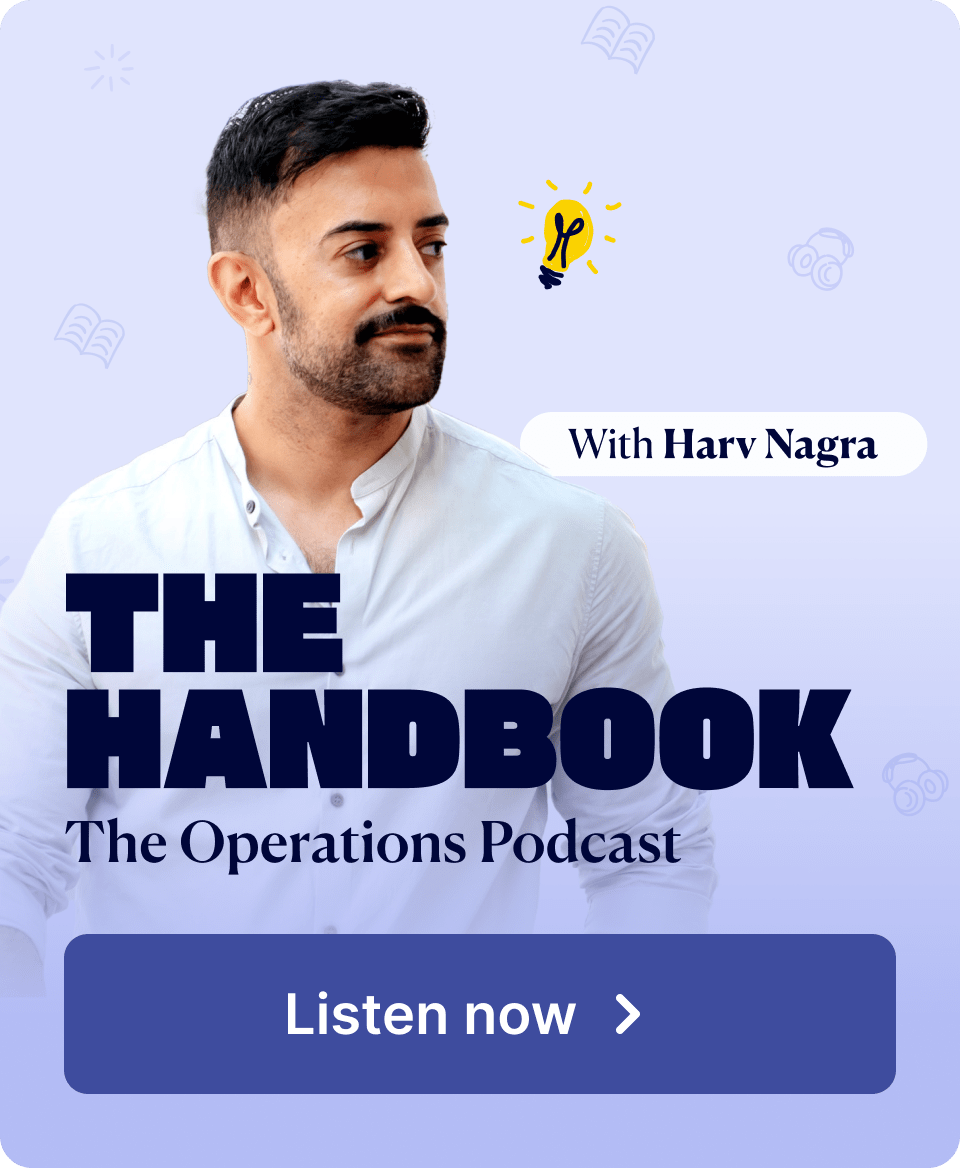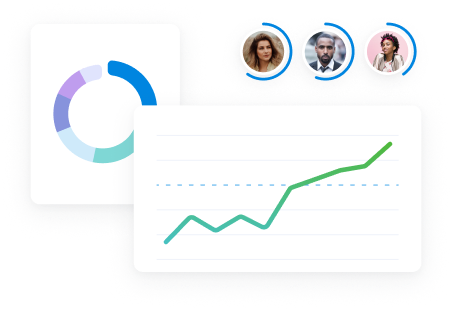Your approach to resource management can make or break your agency’s profitability.
It requires a careful balance between agency capacity and project demands. Which isn’t always easy to achieve—but it’s essential for building a successful agency.
To help you get started with agency resource management, we’ve compiled everything you need, from who’s responsible to how to build a scalable process.
What is resource management for agencies?
Resource management for agencies is the process of distributing different people, hours, skills, tools, and budgets across projects.
Good resource management is the key to maximizing billable utilization and profit margins without causing burnout or missed deadlines.
Agencies typically need to manage five types of resources:
- People: Employees and contractors
- Time: Monitoring availability, logged hours, and balancing billable vs. non-billable hours
- Skills: The expertise needed to complete projects
- Tools: Software and equipment
- Budgets: An estimate of all the costs required to deliver the project
Key roles and responsibilities for managing agency resources
The resource management process shouldn’t be up to just one person. Teamwork is key to using resources well.
| Role | What they do | Key responsibilities |
|---|---|---|
| Project Manager | Oversees specific projects and manages team assignments to keep projects on track | – Plans and allocates resources based on the project scope, deadlines, and priorities- Monitors project progress and adjusts assignments as needed- Communicates with clients and stakeholders about expectations and helps resolve resource conflicts |
| Operations/Resource Manager | Manages overall resource allocations across the agency, monitoring team capacity and efficiency | – Balances workloads across teams to prevent under/overutilization- Forecasts capacity needs by analyzing sales pipelines, project timelines, and team availability- Optimizes resource utilization by reassigning work and identifying hiring or freelancer needs |
| Team Lead | Leads a specific department or area (e.g., design, development, copywriting) and helps team members plan workloads | – Collaborates with the project manager on task assignments to give input on skills and availability- Ensures work quality and coaches team members – Flags overbooked or underutilized team members to the project manager or operations/resource manager |
Resource management steps for agencies
Use our five-step framework to guide your agency’s resource management.
Step 1: Review upcoming project demand
You should start resource management by understanding what work is most likely to land on your team.
This prevents last-minute scrambles and gives you time to plan properly.
Start by checking your sales pipeline, focusing on projects in the “Scoping” or “Proposal” or stage.
Depending on where a lead is, you may have already done some level of scoping.
For example, by the time an opportunity/enquiry reaches the “Proposal” stage, you should have a high-level sense of the project’s needs.
At least enough to build a quote or ballpark estimate (e.g., rough timelines, budget ranges, roles required).
Use that information to answer three key questions:
- Which projects are most likely to move forward?
- What broad resources (roles/skills) will they require?
- When will the work likely need to start?
Forecasting demand at this stage allows you to capacity plan well ahead of delivery. So you’re not scrambling for last-minute coverage, overbooking team members, or delaying project kickoffs.
This early view is especially valuable when multiple high-value projects hit your pipeline at once and compete for immediate attention.
Resource planning software like Scoro makes it easy to review upcoming projects.
With the “Sales pipeline,” you can monitor all potential work and which stages different deals are at (i.e., Opportunity, Scoping, Proposal, Confirmed).
Focus primarily on projects in the “Proposal” stage that have an 80% chance of moving forward.
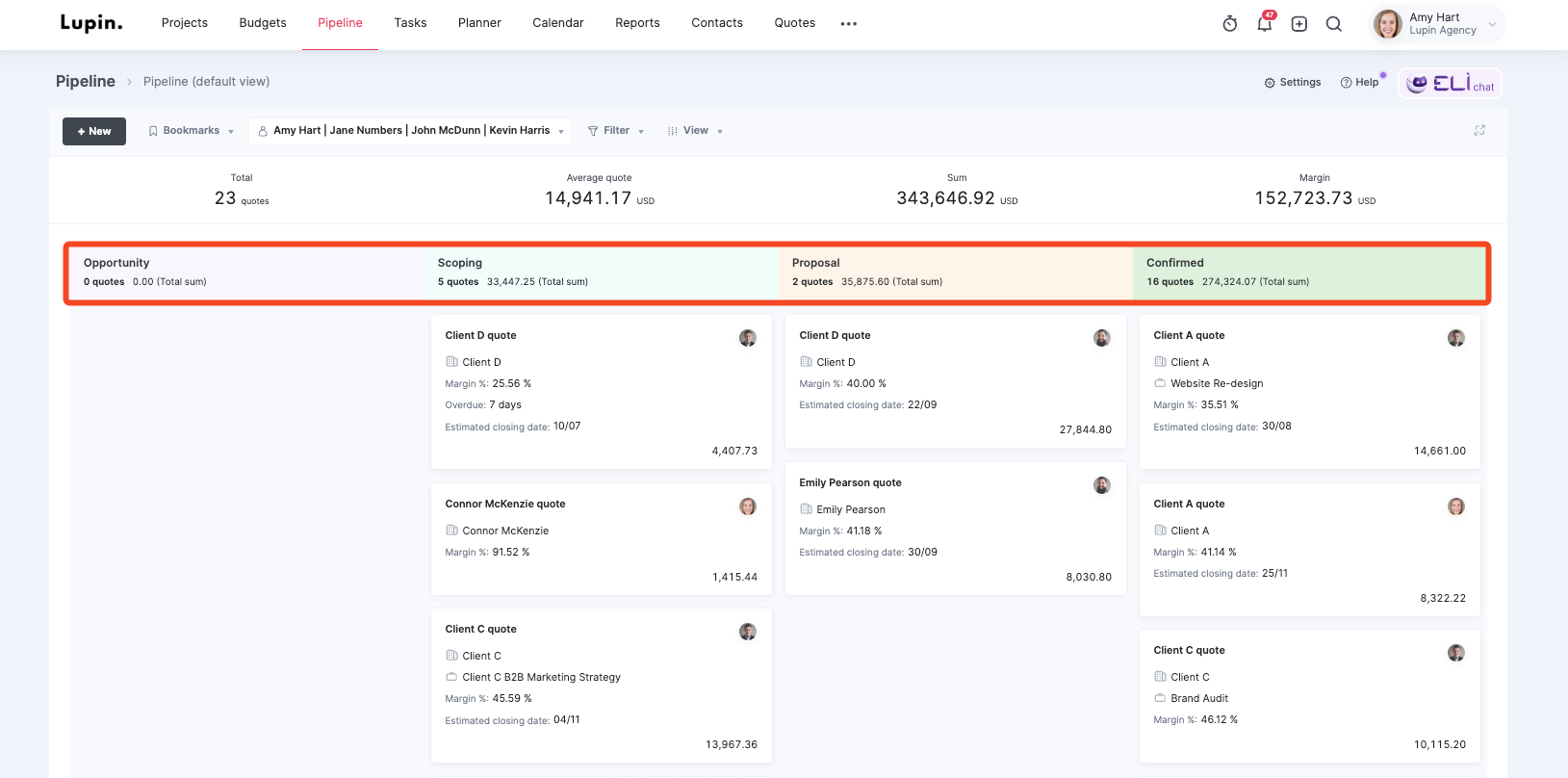
From there, you can click into any quote to see estimated timelines, budgets, and workload.
For example, in the quote below you can already see the broad deliverables (Design, Copywriting), their estimated timelines, and ballpark hours per role.
That’s usually enough to start mapping out likely resource demand, even if details will be refined later.
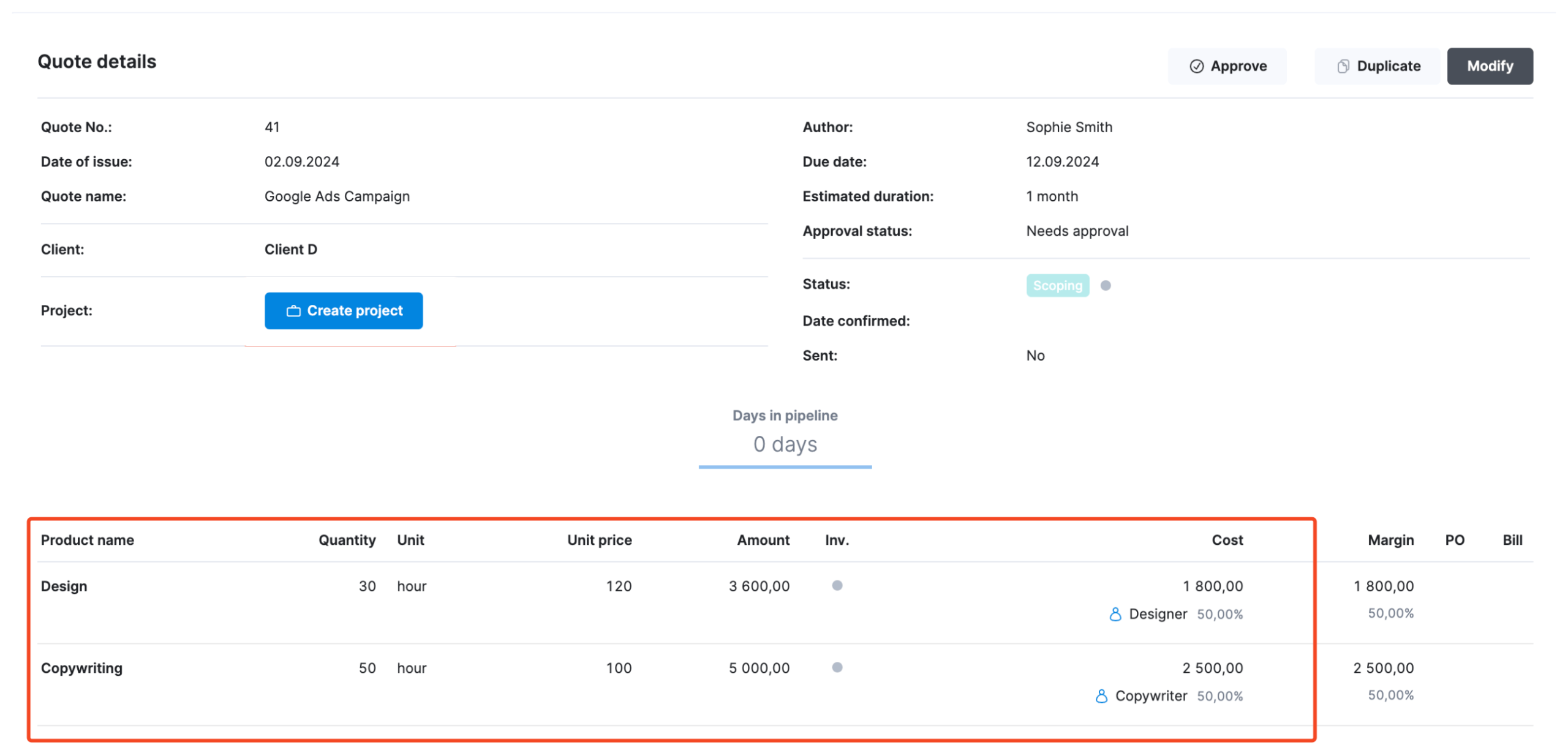
Once you understand what’s coming down the pipeline, the next step is deciding which projects deserve priority.
Step 2: Prioritize projects based on urgency, value, and fit
Once you know what’s in the pipeline, the next step is to decide which projects deserve priority.
This is especially important for projects moving from the Scoping phase into the Proposal stage.
At that point, you should start testing resource planning scenarios: checking whether you have the right people available when the project is likely to kick off.
Without clear prioritization, teams risk being pulled into too many “urgent” tasks that don’t actually matter, leading to delays on critical work, missed deadlines, and employee burnout.
When evaluating projects, consider these factors:
- Urgency: When is the project deadline? When do you need to start the work?
- Margin: What percentage of your project revenue will remain after subtracting pass-through expenses (e.g., vendor and contractor fees)?
- Value: Does the client have the potential to create greater value for your agency?
- Resource availability: Do you have the people, skills, time, tools, and budget necessary for the project?
Scoro’s “Profitability by projects” report helps you see which types of projects consistently drive margins. And which ones drag profitability down. Use this to validate where your team should focus.

A simple way to prioritize is to sort projects into four categories:
- High urgency and high importance: Projects that have tight timelines and offer lucrative opportunities
- High importance and low urgency: Projects that offer high value but have more flexible deadlines
- High urgency and low importance: Projects that offer lower value but have pressing deadlines
- Low urgency and low importance: Projects that offer the lowest impact and lack immediate deadlines
With priorities set, you can now take a closer look at what each project actually requires in detail.

Pro Tip: Beyond urgency and fit, we recommend only investing in detailed resource planning for projects you’re confident you want to pursue. You can use the F.A.S.T. framework to filter first—so you’re not burning time on opportunities that won’t move forward.
Step 3: Define what each project needs
Once you’ve prioritized which projects are worth pursuing, the next step is to scope them in more detail—so you can confidently move them into the Proposal stage.
By this point, you’ll already have a rough sense of deliverables, timelines, and roles from intake.
Now it’s about going deeper: breaking the work into phases, identifying the skills required, and estimating time commitments.
For agencies, this often means scoping at the task level rather than just phases.
Breaking work down into tasks ensures your proposal isn’t just a ballpark. It reflects how the project will actually be delivered and makes resource planning far more reliable.
A resource breakdown structure (RBS) is a simple way to do this.
By outlining roles, skills, and hours per phase or task, you can assign the right people, set achievable deadlines, and balance workloads across your team.
For example, a simple Google Ads campaign broken into phases and tasks might look like this:
Design – 30h
- Create ad concept mockups → 10h
- Design ad variations (3–4 formats) → 15h
- Final polish & exports → 5h
Copywriting – 50h
- Draft ad copy (5 variations) → 20h
- Write long-form landing page copy → 20h
- Client revisions & edits → 10h
Once you’ve mapped out an RBS, Scoro’s quote builder makes it easy to translate that structure into a resource and financial plan:
- For repeat projects → quickly add standard phases and roles from Scoro’s quote templates
- For complex projects → expand with custom line items, phases, and hours to reflect the real breakdown of work.
Each quote line shows hours, roles, costs, and margins upfront—so you know whether the project will be profitable before you commit.
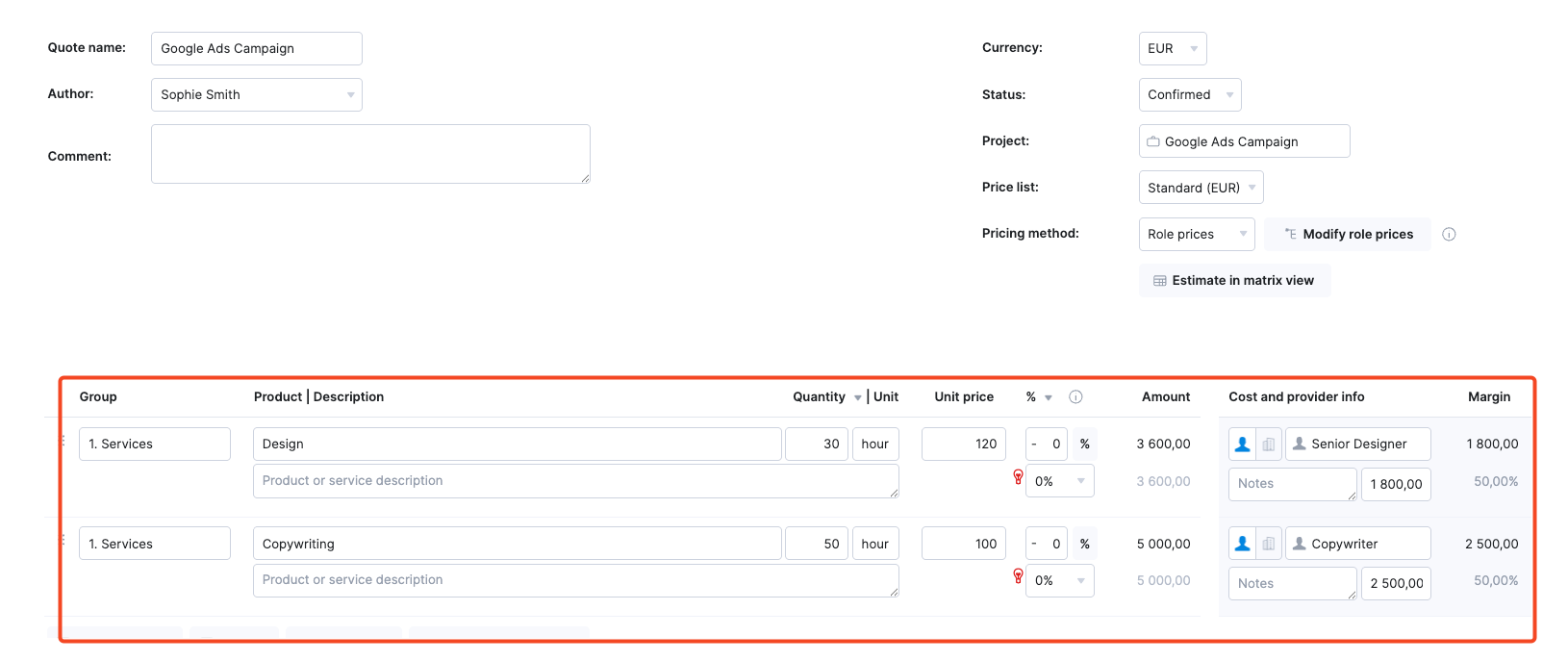
Once the proposal is signed, you can convert the quote into a project and immediately create tasks from the quote’s phases or activities.
For example, a line for Design (30h) or Copywriting (50h) can be used to generate the tasks you defined in your RBS (more on this in step 5).
And with Scoro’s matrix quoting, a single deliverable can be split across multiple roles behind the scenes.
For example, in the Google Ads campaign quote, the client simply sees:
- Design – 30h
- Copywriting – 50h
But internally, Design (30h) is split between a Junior Designer (20h) and a Senior Designer (10h). This gives you a much clearer picture of how the workload will be distributed, the actual cost per role, and the resulting profit margin.

Step 4: Assess your team’s current capacity
With project requirements defined and built into your proposal, the next step is to check whether your team actually has the capacity to deliver.
This means reviewing your full-time team’s current workload, planned time off, and any external resources you might rely on (freelancers, contractors).
Skipping this step creates two risks:
- Overcommitment → team members are booked beyond their limits, leading to burnout or delayed kickoffs
- Underutilization → staff have too little billable work, dragging down profitability
This step is also critical for managing your team’s resource utilization.
In Scoro, take your quote and click the “Create project” button to convert it into a project.

Then, open the “Bookings” module. From the “Grouped by” menu, select “Roles.”
Expand the role you need to assess (e.g., Designer) to see who’s at or over capacity versus who still has bandwidth.
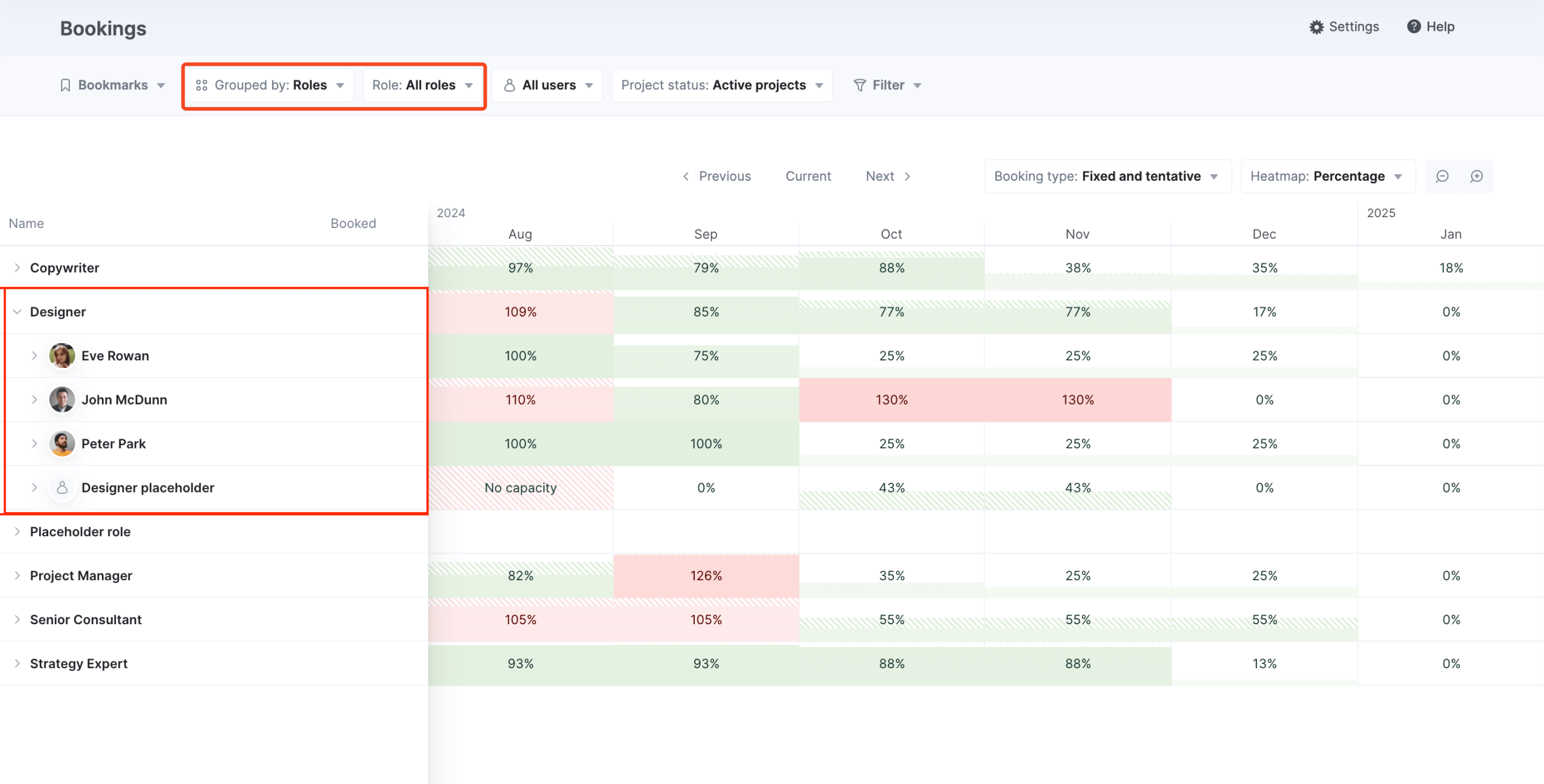
Then, switch the heatmap to “Remaining hours” and zoom to the week level to see weekly headroom.
In the example below, Peter is fully booked; Eve and John still have capacity. Eve shows ~10h available each week in September, making her a good fit for the Google Ads Campaign project we just converted from the quote.
And you’ll see that the tentative bookings were already made when creating the project from the quote (shown in blue stripes).
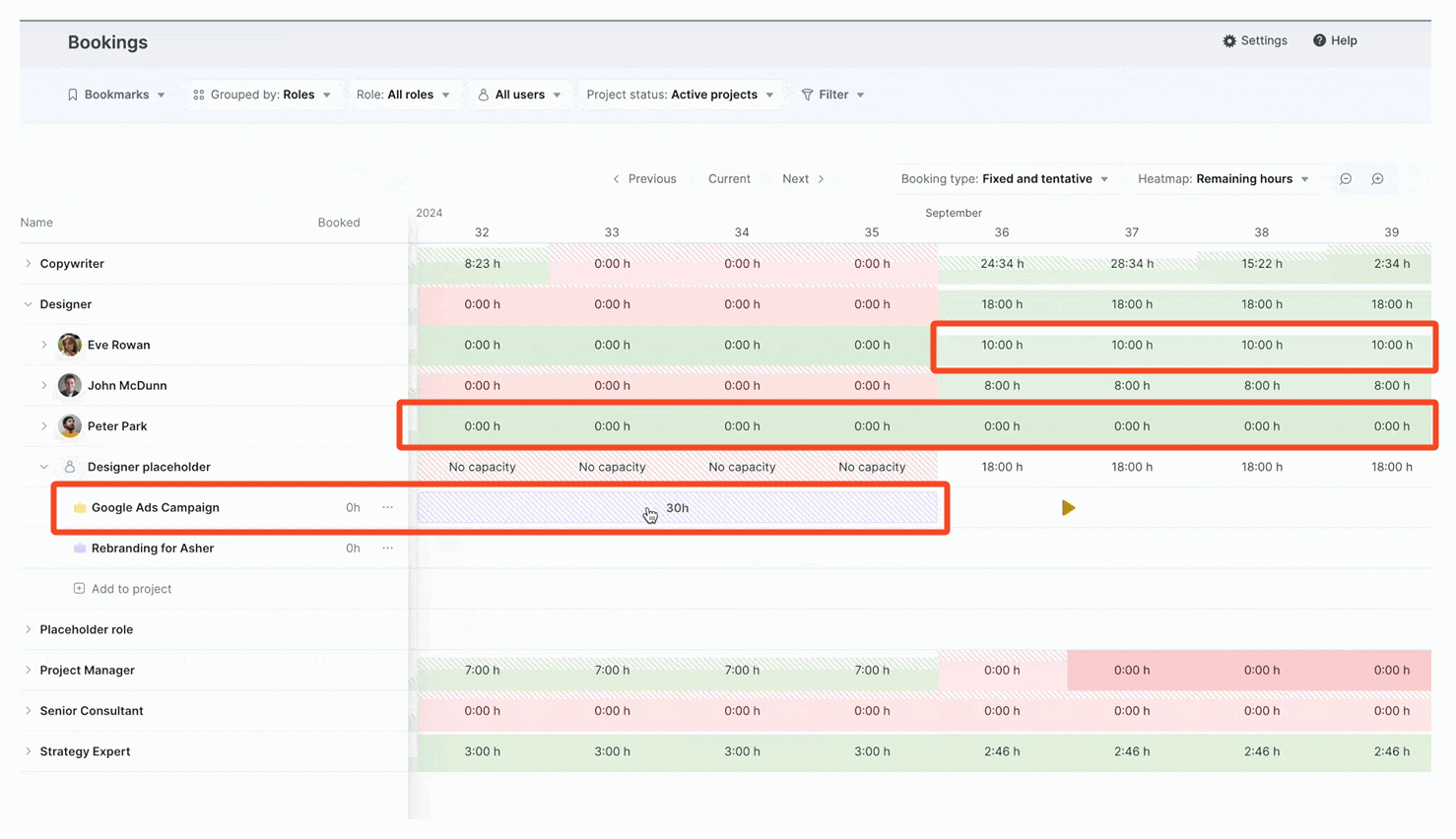
From here, you can simply transfer the placeholder booking to Eve. Locking in a realistic plan without overloading anyone.

If demand is tight, test “what-if” scenarios (e.g., shifting start dates, splitting work across two designers, or using a freelancer) before finalizing bookings. This keeps utilization healthy and protects delivery dates.
Step 5: Assign work to your team
Your RBS (from Step 3) gives you the blueprint of what needs to be done. Now it’s about translating that structure into tasks your team can actually execute.
At this stage, the client project has likely been signed off and you’re moving from planning into delivery.
Now, how granular you get here depends on your work:
- If you’re donig more consulting tyoe work, you may only plan at the phase level (e.g., “Submit feasibility report”).
- If you’re a creative or marketing agency you may usually break work down into detailed tasks (e.g., “Draft ad copy”, “Design campaign assets”) so day-to-day progress and accountability are easier to track.
For more granular resource planning, use Scoro’s “Planner.” It’s helpful for planning daily work, scheduling tasks, and tracking utilization.
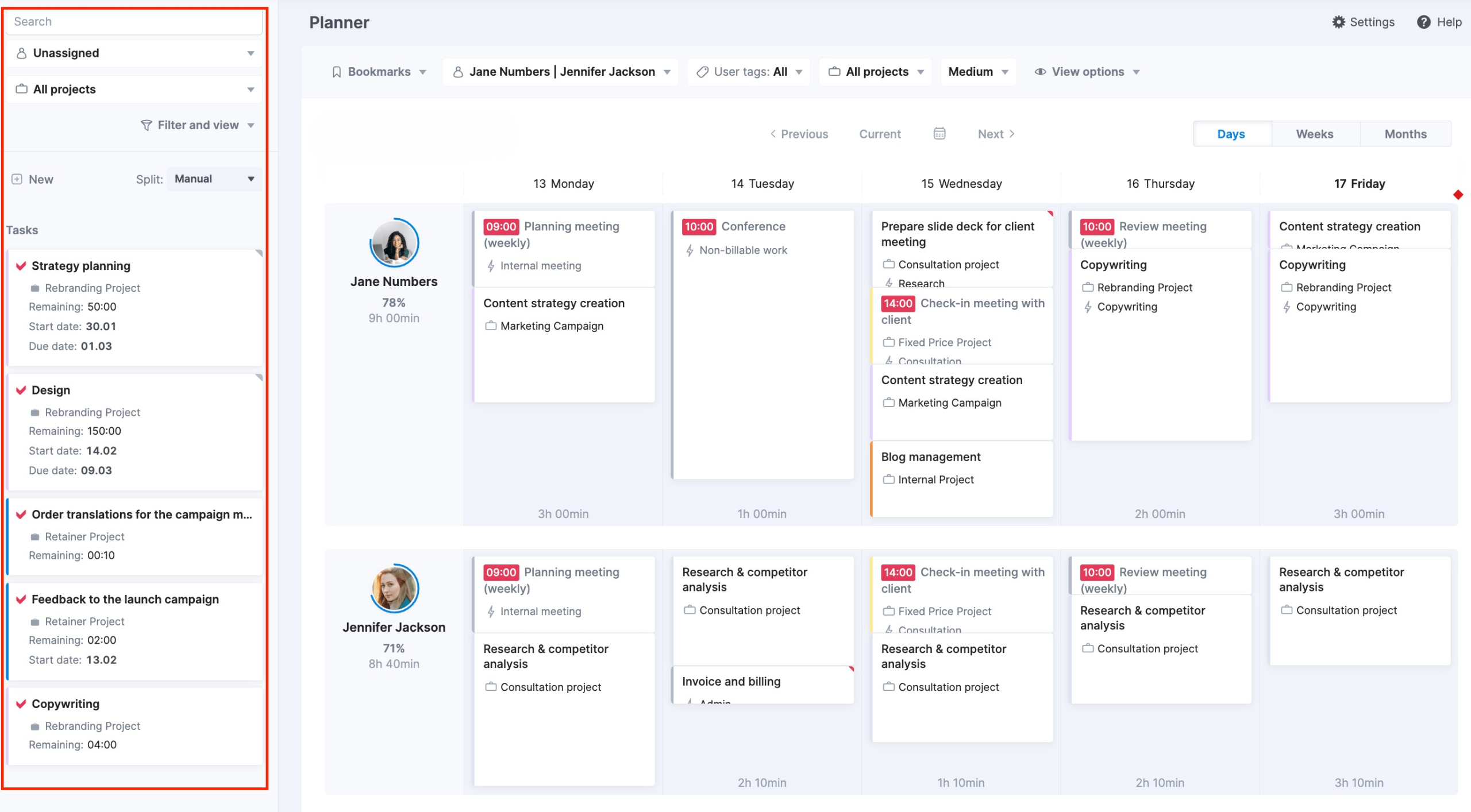
Keep a centralized resource management system
There’s no need to manage agency resources manually. Instead, use a system that tracks availability, workloads, and assignments across all team members.
With Scoro, you avoid double-booking, underutilization, and last-minute scheduling conflicts. And you gain improved billable utilization and increased profitability.
Take Wiktor Leo Burnett. The Slovakian group’s advertising agencies used different resourcing tools. Which led to resource conflicts and overwork.
But after adopting Scoro, the agency had a better view of team workloads and developed more efficient workflows. Which let agency project managers regain 15% of their days, freeing up time for higher-value work.
Want to improve your agency resource management and increase profitability? Try Scoro for free for 14 days.





